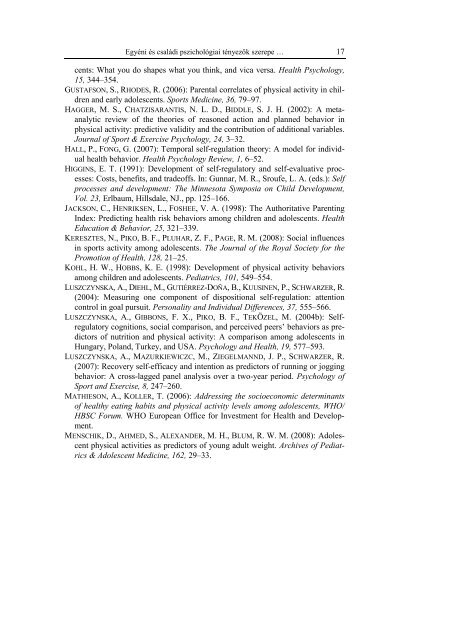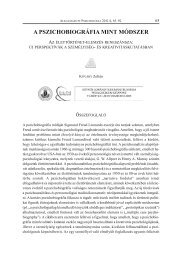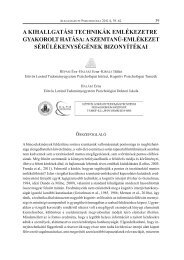16 BRASSAI LÁSZLÓ – PIKÓ BETTINAASZMANN, A. (szerk.) (2003): Iskoláskorú gyermekek egészségmagatartása.Egészségügyi Világszervezet nemzetközi kutatásának keretében végzett magyarvizsgálat. „Nemzeti Jelentés” 2002. Országos Gyermekegészségügyi Intézet,Nemzeti Drogmegelőzési Intézet, Budapest.BANDURA, A. (1997): Self-efficacy: The exercise of control. W. H. Freeman, NewYork.BAUER, C. W., NELSON, M. C., BOUTELLE, K. N., NEUMARK-SZTAINER, D. (2008):Parental influences on adolescents’ physical activity and sedentary behavior:longitudinal findings from Project EAT-II. International Journal of BehavioralNutrition and Physical Activity, 5, 1479–1486.BASS, S. (2000): The prepubertal years: a unique opportune stage of growth whenthe skeleton is most responsive to exercise? Sports Medicine, 30, 73–78.BECH, P., GUDEX, C., JOHANSEN, K. S. (1996): The WHO (Ten) Well-Being Index:validation in diabetes. Psychotherapy and Psychosomatics, 65, 183–190.BECH, P. (1999): Health-related quality of life measurements in the assessment ofpain clinic results. Acta Anaesthesiologica Scandinavica, 43, 893–896.BEETS, M. W., VOGEL, R., CHAPMAN, S., PITETTI, K. H., CARDINAL, B. J. (2007):Parent’s social support for children’s outdoor physical activity: Do weekdaysand weekends matter? Sex Roles, 56, 125–131.BIDDLE, S. J. H., FOX, K. R., BOUTCHER, S. H. (eds.). (2000): Physical activity andpsychological well-being. Routledge, London.BIDDLE, S. J. H., GORELY, T., STENSEL, D. J. (2004): Health-enhancing physicalactivity and sedentary behaviour in children and adolescents. Journal of SportsSciences, 22, 679–701.CSABAI M., ERŐS F., FÁBIÁN Z., KOVÁCS A., LÁSZLÓ J., PÓLYA T. (1998): Azegészség szociális reprezentációja a budapesti középiskolások körében. MTA<strong>Pszichológia</strong>i Intézete, Budapest.DIXON, R. S., GILL, G. M. V., ADAIR, V. A. (2003): Exploring paternal influenceson the dieting behaviors of adolescent girls. Eating Disorders, 11, 39–50.EATON, D. E., KANN, L., KINCHEN, S., ROSS, J, HAWKINS, J., HARRIS, W. A.,LOWRY, R., MCMANUS, T., CHYEN, D., SHANKLIN, S., LIM, C., GRUNBAUM, J. A.,WECHSLER, H. (2006): Youth Risk Behavior Surveillance – United States, 2005.Centers for Disease Control and Prevention. Surveillance Summaries. Vol. 55 /No. SS-5.ECCLES, J., HAROLD, R. D. (1991): Gender differences in sport involvement: Applyingthe Eccles’ expectancy-value model. Journal of Applied Sport Psychology,3, 7–35.ECCLES, J. S., WIGFIELD, A. (2002): Motivation, beliefs, and goals. Annual Reviewof Psychology, 53, 109–132.GERRARD, M., GIBBONS, F. X., BENTHIN, A. C., HESSLING, R. M. (1996): A longitudinalstudy of the reciprocal nature of risk behaviors and cognitions in adoles-
Egyéni és családi pszichológiai tényezők szerepe … 17cents: What you do shapes what you think, and vica versa. Health Psychology,15, 344–354.GUSTAFSON, S., RHODES, R. (2006): Parental correlates of physical activity in childrenand early adolescents. Sports Medicine, 36, 79–97.HAGGER, M. S., CHATZISARANTIS, N. L. D., BIDDLE, S. J. H. (2002): A metaanalyticreview of the theories of reasoned action and planned behavior inphysical activity: predictive validity and the contribution of additional variables.Journal of Sport & Exercise Psychology, 24, 3–32.HALL, P., FONG, G. (2007): Temporal self-regulation theory: A model for individualhealth behavior. Health Psychology Review, 1, 6–52.HIGGINS, E. T. (1991): Development of self-regulatory and self-evaluative processes:Costs, benefits, and tradeoffs. In: Gunnar, M. R., Sroufe, L. A. (eds.): Selfprocesses and development: The Minnesota Symposia on Child Development,Vol. 23, Erlbaum, Hillsdale, NJ., pp. 125–166.JACKSON, C., HENRIKSEN, L., FOSHEE, V. A. (1998): The Authoritative ParentingIndex: Predicting health risk behaviors among children and adolescents. HealthEducation & Behavior, 25, 321–339.KERESZTES, N., PIKO, B. F., PLUHAR, Z. F., PAGE, R. M. (2008): Social influencesin sports activity among adolescents. The Journal of the Royal Society for thePromotion of Health, 128, 21–25.KOHL, H. W., HOBBS, K. E. (1998): Development of physical activity behaviorsamong children and adolescents. Pediatrics, 101, 549–554.LUSZCZYNSKA, A., DIEHL, M., GUTIÉRREZ-DOÑA, B., KUUSINEN, P., SCHWARZER, R.(2004): Measuring one component of dispositional self-regulation: attentioncontrol in goal pursuit. Personality and Individual Differences, 37, 555–566.LUSZCZYNSKA, A., GIBBONS, F. X., PIKO, B. F., TEKÖZEL, M. (2004b): Selfregulatorycognitions, social comparison, and perceived peers’ behaviors as predictorsof nutrition and physical activity: A comparison among adolescents inHungary, Poland, Turkey, and USA. Psychology and Health, 19, 577–593.LUSZCZYNSKA, A., MAZURKIEWICZC, M., ZIEGELMANND, J. P., SCHWARZER, R.(2007): Recovery self-efficacy and intention as predictors of running or joggingbehavior: A cross-lagged panel analysis over a two-year period. Psychology ofSport and Exercise, 8, 247–260.MATHIESON, A., KOLLER, T. (2006): Addressing the socioeconomic determinantsof healthy eating habits and physical activity levels among adolescents, WHO/HBSC Forum. WHO European Office for Investment for Health and Development.MENSCHIK, D., AHMED, S., ALEXANDER, M. H., BLUM, R. W. M. (2008): Adolescentphysical activities as predictors of young adult weight. Archives of Pediatrics& Adolescent Medicine, 162, 29–33.
- Page 5: ALKALMAZOTT PSZICHOLÓGIA X. ÉVFOL
- Page 8 and 9: 8 BRASSAI LÁSZLÓ - PIKÓ BETTINAt
- Page 12 and 13: 12 BRASSAI LÁSZLÓ - PIKÓ BETTINA
- Page 14 and 15: 14 BRASSAI LÁSZLÓ - PIKÓ BETTINA
- Page 18: 18 BRASSAI LÁSZLÓ - PIKÓ BETTINA
- Page 21 and 22: ALKALMAZOTT PSZICHOLÓGIA X. ÉVFOL
- Page 23 and 24: Pedagógusok attitűdje az integrá
- Page 25 and 26: Pedagógusok attitűdje az integrá
- Page 27 and 28: Pedagógusok attitűdje az integrá
- Page 29 and 30: Pedagógusok attitűdje az integrá
- Page 31 and 32: Pedagógusok attitűdje az integrá
- Page 33 and 34: Pedagógusok attitűdje az integrá
- Page 35 and 36: ALKALMAZOTT PSZICHOLÓGIA X. ÉVFOL
- Page 37 and 38: Iskolai teljesítményproblémák
- Page 39 and 40: Iskolai teljesítményproblémák
- Page 41 and 42: Iskolai teljesítményproblémák
- Page 43 and 44: Iskolai teljesítményproblémák
- Page 45 and 46: Iskolai teljesítményproblémák
- Page 47 and 48: Iskolai teljesítményproblémák
- Page 49 and 50: Iskolai teljesítményproblémák
- Page 51 and 52: Iskolai teljesítményproblémák
- Page 53 and 54: Iskolai teljesítményproblémák
- Page 55 and 56: Iskolai teljesítményproblémák
- Page 57 and 58: Iskolai teljesítményproblémák
- Page 59: Iskolai teljesítményproblémák
- Page 62 and 63: 62 LUKÁCS-MÁRTON RÉKA - VÁSÁRH
- Page 64 and 65: 64 LUKÁCS-MÁRTON RÉKA - VÁSÁRH
- Page 66 and 67:
66 LUKÁCS-MÁRTON RÉKA - VÁSÁRH
- Page 68 and 69:
68 LUKÁCS-MÁRTON RÉKA - VÁSÁRH
- Page 70 and 71:
70 LUKÁCS-MÁRTON RÉKA - VÁSÁRH
- Page 72 and 73:
72 LUKÁCS-MÁRTON RÉKA - VÁSÁRH
- Page 74 and 75:
74 LUKÁCS-MÁRTON RÉKA - VÁSÁRH
- Page 76 and 77:
76 FARAGÓ KLÁRA - KISS ORHIDEA -
- Page 78 and 79:
78 FARAGÓ KLÁRA - KISS ORHIDEA -
- Page 80 and 81:
80 FARAGÓ KLÁRA - KISS ORHIDEA -
- Page 82 and 83:
82 FARAGÓ KLÁRA - KISS ORHIDEA -
- Page 84 and 85:
84 FARAGÓ KLÁRA - KISS ORHIDEA -
- Page 86 and 87:
86 FARAGÓ KLÁRA - KISS ORHIDEA -
- Page 88 and 89:
88 FARAGÓ KLÁRA - KISS ORHIDEA -
- Page 90 and 91:
90 FARAGÓ KLÁRA - KISS ORHIDEA -
- Page 92 and 93:
92 FARAGÓ KLÁRA - KISS ORHIDEA -
- Page 94 and 95:
94 FARAGÓ KLÁRA - KISS ORHIDEA -
- Page 96 and 97:
96 FARAGÓ KLÁRA - KISS ORHIDEA -
- Page 98 and 99:
98 FARAGÓ KLÁRA - KISS ORHIDEA -
- Page 101 and 102:
ALKALMAZOTT PSZICHOLÓGIA X. ÉVFOL
- Page 103 and 104:
Konfliktustréning és szerződés
- Page 105 and 106:
Konfliktustréning és szerződés
- Page 107 and 108:
Konfliktustréning és szerződés
- Page 109 and 110:
Konfliktustréning és szerződés
- Page 111 and 112:
Konfliktustréning és szerződés
- Page 113 and 114:
Konfliktustréning és szerződés
- Page 115 and 116:
Konfliktustréning és szerződés
- Page 117 and 118:
Konfliktustréning és szerződés
- Page 119 and 120:
Konfliktustréning és szerződés
- Page 121 and 122:
Konfliktustréning és szerződés
- Page 123:
Konfliktustréning és szerződés
- Page 126 and 127:
126 MAJOROSS KINGAtozóbírókat. M
- Page 128 and 129:
128 MAJOROSS KINGAzált beteg és p
- Page 130 and 131:
130 MAJOROSS KINGAmernek vitatkozni
- Page 132 and 133:
132 MAJOROSS KINGAA VIZSGÁLAT MENE
- Page 134 and 135:
134 MAJOROSS KINGA3. táblázat. Ha
- Page 136 and 137:
136 MAJOROSS KINGAérett házasok3,
- Page 138 and 139:
138 MAJOROSS KINGAérett házasok0,
- Page 140 and 141:
140 MAJOROSS KINGAA vizsgálat vég
- Page 142 and 143:
142 MAJOROSS KINGAIRODALOMADLER, A.
- Page 145 and 146:
ALKALMAZOTT PSZICHOLÓGIA X. ÉVFOL
- Page 147 and 148:
Az önmagunkra találás helyei …
- Page 149 and 150:
Az önmagunkra találás helyei …
- Page 151 and 152:
Az önmagunkra találás helyei …
- Page 153 and 154:
Az önmagunkra találás helyei …
- Page 155 and 156:
Az önmagunkra találás helyei …
- Page 157 and 158:
Az önmagunkra találás helyei …
- Page 159 and 160:
Az önmagunkra találás helyei …
- Page 161:
Az önmagunkra találás helyei …
- Page 165 and 166:
ALKALMAZOTT PSZICHOLÓGIA X. ÉVFOL
- Page 167 and 168:
Hazatérni testben és lélekben -
- Page 169 and 170:
Hazatérni testben és lélekben -
- Page 171 and 172:
Hazatérni testben és lélekben -
- Page 173:
Hazatérni testben és lélekben -
- Page 176 and 177:
176 VARGHA ANDRÁSgítségével ír
- Page 178 and 179:
178 VARGHA ANDRÁS„parciális”
- Page 180 and 181:
180 VARGHA ANDRÁSDe mi történik
- Page 182 and 183:
182 VARGHA ANDRÁS(iii) Ugyanez a s
- Page 184 and 185:
184 VARGHA ANDRÁSX változó (b =
- Page 186 and 187:
186 VARGHA ANDRÁSA jelen tanulmán
- Page 188 and 189:
188 VARGHA ANDRÁSTHOUGHTS ABOUT TH
- Page 191 and 192:
ALKALMAZOTT PSZICHOLÓGIA X. ÉVFOL
- Page 193 and 194:
A Klinikai Pszichológiáért Alap
- Page 195 and 196:
ALKALMAZOTT PSZICHOLÓGIA X. ÉVFOL
- Page 197:
CONTENTEMPIRICAL STUDIESBRASSAI, L.








